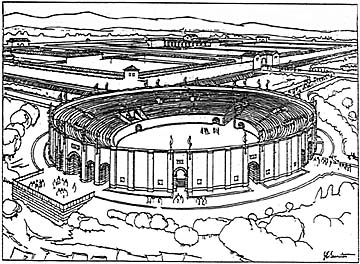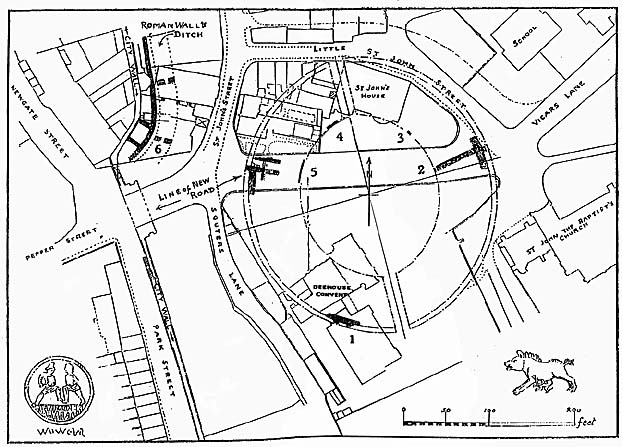Save
the
Chester
Amphitheatre!
Preserve
a
National
Treasure
for
Posterity

Conjectural
restoration
of
the
amphitheatre
in
Roman
times
The
Chester
and
North
Wales
Architectural,
Archaeological
and
Historic
Society
Patrons:
His
Grace
the
Duke
of
Westminster,
GCVO,
DSO
The
Most
Rev.
The
Lord
Archbishop
of
Wales
The
Right
Hon.
The
Earl
of
Stamford
The
Right
Hon.
Lord
Howard
de
Walden
President:
The
Right
Rev.
The
Lord
Bishop
of
Chester
Chairman
of
Council:
Rev.
Canon
R.
A.
Thomas,
OBE,
MA,
FSA
Chairman
of
Excavations
Committee:
The
Ven.
W.
L.
Paige
Cox,
MA,
BD,
Archdeacon
of
Chester
Hon
treasurer:
W.
H.
Evans
Esq.,
Lloyds
Bank
Ltd,
Chester
Hon.
Secretary:
B.
T.
Williams
Esq.,
MA,
FRGS,
Arnold
House,
Chester
HISTORY
OF
THE
FIND
Three
years
ago,
at
the
time
of
the
extension
of
the
Ursuline
Convent
just
outside
the
Newgate,
a
massive
buttressed
wall,
nine
feet
thick
and
obviously
of
Roman
construction,
was
revealed.
Later,
during
preliminary
clearing
on
the
site
of
the
proposed
by-pass
road,
two
hundred
feet
north
of
this
spot,
deliberate
excavations
brought
to
light
another
small
section
of
the
structure.
Professor
Newstead,
F.R.S.,
and
Professor
Droop,
M.A.,
F.S.A
(of
the
University
of
Liverpool)
then
conducted
trial
excavations
on
the
site
which
revealed
the
existence
of
a
long-forgotten
Roman
amphitheatre
of
the
late
1st
Century
A.D.
From
such
investigation
as
the
present
lay-out
of
the
ground
has
permitted,
it
is
evident
that
the
whole
structure
was
one
of
the
largest
and
most
important
buildings
of
this
class
erected
in
Britain
during
the
Roman
occupation.
Confirmation
of
this
view
is
provided
by
the
following
extracts
from
opinions
offered
by
acknowledged
authorities:
Sir
George
MacDonald writes:
"It
would
be
a
thousand
pities
if
the
amphitheatre
were
to
be
irrevocably
sealed."
Mr
R.
G.
Collillgwood
describes
it
as
"a
relic
of
altogether
exceptional
interest
and
in
every
way
finer
than
Caerleon."
Dr.
Cyril
Fox,
Director
of
the
National
Museum
of
Wales,
urges
that
every
effort
be
made
to
divert
the
roadway
and
that
a
section
of
the
amphitheatre
should
be
opened
up
as
an
ancient
monument.
Dr.
Mortimer
Wheeler,
Keeper
of
the
London
Museum says:
"From
an
archaeological
and
historical
standpoint,
it
is
probable
that
the
scientific
excavation
of
this
structure
would
throw
a
new
light
upon
the
early
history
of
this
country."
Large
sections
of
the
outer
ashlar-faced
wall,
some
nine
feet
thick,
the
earth
bank
and
radial
walls
on
which
the
tiers
of
seats
rested
and
the
inner
arena
wall,
standing
in
one
place
to
a
height
of
nine
feet,
have
been
unnearthed
at
five
widely-separated
points,
thus
making
possible
a
tentative
reconstruction
of
the
whole
plan.
The
structure
was
clearly
a
stoutly-built
oval
with
a
major
axis
of
approximately
310
feet
in
length
and
a
minor
of
284
feet,
capable
of
accommodating
ahout
9,000
spectators,
and
was
used
for
gladiatorial
shows,
beast-fights
and
similar
entertainment
for
the
legionaries
and
civilians
of
this
remote
frontier
fortress.
PRESENT
POSITION
Across
the
centre
of
this
area,
it
is
proposed
to
build
a
new
by-pass
road.
Even
if
the
monument
were
not
damaged
(and
some
damage
seems
inevitable)
it
would
be
irretrievably
lost
to
archaeological
exploration.
But
an
alternative
route
is
available,
following
the
line
of
the
mediaeval
Little
St.
John
Street,
which
will
save
the
site
and
make
a
safer
and
more
graceful
approach
to
the
new
gateway
about
to
be
constructed
in
the
City
Walls.
His
Majesty's
Commissioners
of
Works
are
so
much
impressed
with
the
historical
and
antiquarian
significance
of
the
discovery
that
they
have
offered
to
defray
the
cost
of
excavation
of
half
the
amphitheatre
site
(which
alone
is
available
at
the
moment).
Further,
they
have
urged
the
City
Council
to
delay
operations
in
order
to
give
the
Chester
Archaeological
Society
a
final
ooportunity
to
raise
the
funds
required
to
meet
the
added
cost
of
deflecting
the
road
and
of
purchasing
properties
so
that
the
space
may
be
cleared
for
excavation.
The
policy
of
the
Society
is:
(i)
To
raise
£8,000
to
deflect
the
road
away
from
the
Amphitheatre
(ii)
To
raise
a
further
£8,000
to
purchase
properties
on
the
site
(iii)
To
have
the
whole
northern
half
excavated
and
presered
bv
H.M.
Office
of
Works
Donations
and
promises
amounting
to
£600
have
already
been
made.
BUT
ONLY
THREE
MONTHS
REMAIN!
So
ambitious
a
scheme
calls
for
the
enthusiastic
and
generous
support
of
all
lovers
of
antiquities.
The
proprietor
ot
the
Plane
Tree
Cafe
at
once
offered
£100
on
condition
that
fourty
nine
others
gave
a
like
amount:
some
have
done
so.
We
appeal
to
far-sighted
business
men
to
follow
suit.
If
you
sympathise
with
this
attempt
to
rescue
a
priceless
relic
of
our
ancient
heritage
and
to
preserve
it
for
posterity,
please
send
a
contribution
as
quickly
as
possible.
Cheques
and
postal
orders
shou'd
be
crossed
and
made
payable
to
thc
Chester
Roman
Amphitheatre
Fund,
and
sent
to
Lloyds
Bank
Ltd.,
Chester.
For
your
convenience
a
subscript
on
form
and
adressed
envelope
are
enclosed.
April
12th
1932

Plan
shewing
alternative
route
|

